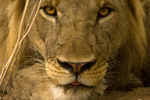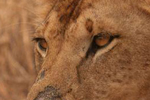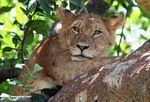Shivani Bhalla will be speaking at the Wildlife Conservation Network Expo in San Francisco on October 12th, 2013.
In 2009 conservationists estimated that less than 2,000 lions survive in Kenya, a drop of 26 percent in just seven years. In addition, the East Africa country continues to hemorrhage lions: around a hundred a year. Poaching, poisoning, and large-scale habitat loss has put lions on the defensive across Africa, but even countries once thought lion strongholds–like Kenya–have seen populations harried to devastation and in some cases local extinction. Shivani Bhalla, a fourth-generation Kenyan, is working to turnaround this trend in Samburu National Reserve.
Bhalla first moved to Samburu in 2002 to study cheetahs for her Master’s, but she says, “I didn’t see a single cheetah, but did see lions in small groups, in pairs, or on their own. These behavioral patterns I saw in Samburu’s lions, which were different from childhood memories of safaris where I saw prides of up to 10 individuals, prompted a shift in my focus.”
Her expert understanding of Samburu’s lions underpinned her creation of the Ewaso Lions organization in 2007. Ewaso Lions works with local people, most notably the Samburu tribe, to mitigate conflict with lions. The young group’s action includes employing Samburu warriors to track wildlife and report predation, kickstarting wildlife clubs for kids, and using safari guides to collect data on lions.
 Samburu lion tagged for tracking. Photo by: Ewaso Lions. |
“Our successful Warrior Watch program, which engages, trains, and helps the warrior-class to become active wildlife ambassadors in their communities, has not only helped us gain a better understanding of wildlife numbers, distribution, poaching, and conflict over a wider area and on a much larger scale than before, but has contributed towards building local capacity and providing these young men with the education to develop and enhance their skills,” Bhalla explains.
Today, Samburu is home to 40 lions, the highest number in over a decade. But one of the most surprising things about working in Samburu is not the lions, however important, but the local tribe, which differs from some other notable African tribes by having a more tolerant view of top predators in general.
“Samburu lore indicates that if one’s cow is attacked by a lion, blessings and riches befall that family in all their endeavors. We have found that often the Samburu people would only target lions if they have lost numerous livestock to them. They no longer hunt lions for ceremonial reasons and are beginning to realize their importance to the ecosystem,” Bhalla says, adding that, “[the Samburu] are essential in ensuring a future for lions as they are the ones who know the lions—their whereabouts and their needs.”
Shivani Bhalla will be presenting at the up-coming Wildlife Conservation Network Expo in San Francisco on October 12th, 2013, an event which will be headed by Jane Goodall.
INTERVIEW WITH SHIVANI BHALLA

Samburu warriors tracking lions with Shivani Bhalla (far right). Photo by: Ewaso Lions.
Mongabay: What drew you to lions?
Shivani Bhalla: I have always been keenly interested in wildlife conservation, and have long had a particular fascination for big cats. I am a 4th generation Kenyan and childhood safaris with my parents across Kenya confirmed my passion for animals. Shortly after moving to Samburu in 2002, I heard about a unique occurrence where a lioness had adopted a baby oryx antelope in Samburu National Reserve. My subsequent collaboration with big cat expert Saba Douglas-Hamilton, who was capturing this unusual story on film, gave me a unique insight into the lions of this region. That was the beginning of my current lion conservation and research work in the Ewaso Nyiro ecosystem in northern Kenya.
During this time, I was attempting to research cheetahs in the area for my Master’s thesis—I didn’t see a single cheetah, but did see lions in small groups, in pairs, or on their own. These behavioral patterns I saw in Samburu’s lions, which were different from childhood memories of safaris where I saw prides of up to 10 individuals, prompted a shift in my focus. Within a few months, I identified all the lion prides in the area and used the data in my Master’s thesis. This study was a first, since no one had, up to that point, conducted any extensive research into the lions of the Ewaso Nyiro ecosystem. My research revealed that lions moved frequently between the National Reserves and community areas adjacent to the Reserves especially in the wet seasons. It also supported the hypothesis that this region is extremely critical for lion dispersal in all of northern Kenya.
It was evident that there was much more to learn about this lion population and the threats they face, especially as their movements led to increased encounters and conflicts with the local people that live adjacent to the Reserves. So I took this study further, embarked on a Ph.D. and founded the Ewaso Lions Project in 2007.
Mongabay: Lions have undergone a terrible decline in the last century. What have been the primary drivers of this decline?

Lion silhouette in Samburu. Photo by: Ewaso Lions.
Shivani Bhalla: The African lion population has declined by 30-50% in the past 20 years and lions have disappeared from at least 83% of their historical range in Africa. This reduction in lion numbers is due to habitat loss and conflict with humans, primarily over livestock depredation. With Kenya’s lion population now numbering less than 2,000, and with continued losses of approximately 100 lions a year, lions in Kenya could become extinct in the next two decades.
Lions require large areas of habitat for their survival. Their movement depends on the availability of prey and places where they can hide and rest during the day. Due to increased land fragmentation and habitat loss, their movements take them into areas inhabited by people. These encounters often lead to conflict when lions attack livestock, and herders retaliate by fatally shooting, spearing, or poisoning lions and other large carnivores.
The greater Ewaso Nyiro ecosystem in northern Kenya is a key area for large carnivores and supports the country’s third largest lion population. This region, which includes parts of Samburu, Laikipia, and Isiolo Counties, serves as a key linkage with carnivore populations further north. Lions in this area frequently move between protected areas and adjacent communal lands, and move into community areas in search of food especially when their natural prey disperses from protected areas during the wet season. During these times, people often experience livestock loss to lions and other predators, and this leads to conflict and eventual retaliation against these carnivores.
Mongabay: How are lions faring in Samburu National Reserve?

Lion cub. Photo by: Ewaso Lions.
Shivani Bhalla: We have been monitoring the lion population in the region since 2002. This includes Samburu, Buffalo Springs, and Shaba National Reserves and the Community Conservancies surrounding these protected areas. The population dropped considerably in 2006 and 2007 when we lost an entire pride that left the safety of the protected areas. Only one female returned. At this time, we also had a period where no cubs were born. Subsequently, the population started increasing in 2008 with new births and 100% cub survival. In 2009, the region faced a severe drought—although this was devastating for livestock, people, and herbivores, the lions fared well during this time as they preyed on the weaker animals and carcasses of those that succumbed to the drought. The population has continued to increase since 2009 and we are now monitoring the highest number of lions since 2002—40 individuals.
Mongabay: How do you convince local communities to see lions as assets and not dangerous pests?
Shivani Bhalla: I realized during my years of working within this human-dominated landscape, that local people would not care about the wildlife they live with unless their livelihoods are protected and they realize the value of wildlife to the ecosystems and economic health of their areas. Therefore, I’ve always valued the importance of combining conservation with development activities, such as spreading awareness, capacity building through training, providing jobs and education, and providing communities with the tools to protect their livestock and alleviate human-wildlife conflict, in order to achieve lasting, long-term solutions to the problems wildlife and people face in this area.
Awareness is the key to ensuring that these local communities see lions as important assets within their landscapes. With this in mind, Ewaso Lions’ conservation efforts focus on building awareness and providing tools for coexistence through a variety of community programs that include conservation education, alleviating human-carnivore conflict, and building local conservation capacity. Our community programs include Warrior Watch, Wazee Watch, Boma Watch, and Lion Watch programs; conducting Ranger and Warrior training workshops; holding Lion Kids Camps; providing school support in the form of bursaries and setting up of Wildlife Clubs.
Our successful Warrior Watch program, which engages, trains, and helps the warrior-class to become active wildlife ambassadors in their communities, has not only helped us gain a better understanding of wildlife numbers, distribution, poaching, and conflict over a wider area and on a much larger scale than before, but has contributed towards building local capacity and providing these young men with the education to develop and enhance their skills, as well as educate their peers and community members of the importance of wildlife.
Mongabay: Will you tell us about working with the Samburu tribes? Why are they so essential to lion survival?

Female lions. Photo by: Ewaso Lions.
Shivani Bhalla: The Samburu people have always lived with wildlife. They have many legends in which wildlife play a major role and are an essential part of their culture. The Samburu have historically been more tolerant of wildlife than some of the other ethnic groups that live alongside them, and it is this tolerance and benevolence that is critical for ensuring long-term survival of lions and other carnivores in the region.
Samburu lore indicates that if one’s cow is attacked by a lion, blessings and riches befall that family in all their endeavors. We have found that often the Samburu people would only target lions if they have lost numerous livestock to them. They no longer hunt lions for ceremonial reasons and are beginning to realize their importance to the ecosystem. Samburu warriors in particular live in the bush and are the eyes and ears of their communities. They are superb trackers and have a real eye for locating lions. They are essential in ensuring a future for lions as they are the ones who know the lions—their whereabouts and their needs—and now with their help, we can work towards ensuring a secure future for lions in the area.
Mongabay: You recently co-authored a paper suggesting that fencing lion populations may be the best means of protecting them. Will you tell us about this idea? Also, what do you say to other lion researchers who believe this is a flawed strategy?
Shivani Bhalla: In our study area, lions exist in low densities but are found throughout the landscape. The total number of lions in the wider area is quite substantial, and make up probably the second largest lion population in Kenya. Although lion numbers within the protected areas is significant, these protected areas are not big enough to provide territory and resources for these lions, so they are constantly moving into the community areas surrounding the Reserves. Therefore, fencing is not an option for this particular population. Lion movement data shows that lions in this population and in southern Kenya (the biggest remaining population in Kenya) use pastoralist areas extensively. Fencing just the protected areas in these landscapes would lower the overall viability of these populations since it would not allow for wide dispersal and genetic diversity in breeding. Fencing might be an option for very large protected areas, but not for lions surviving in land-use mosaics such as the ecosystem we work in. I am a strong believer of community-based conservation and believe that lions are able to live with people, as long as livestock loss to lions is minimized, people tolerate lions, and safe refuges exist for lions to permeate through human occupied lands.
I was listed as an author since I contributed data towards the paper. However, I believe the conclusions were meant to highlight the potential value of one conservation tool in relevant situations, not to provide a one size fits all solution to lion conservation.

Shivani Bhalla. Photo by: Ewaso Lions.

Lion with oryx prey. Photo by: Ewaso Lions.

Tracking team. Photo by: Ewaso Lions.

Investigating dead lion. Photo by: Ewaso Lions.
Related articles
Lions rising: community conservation making a difference for Africa’s kings in Mozambique

(09/17/2013) Everyone knows that tigers, pandas, and blue whales are threatened with extinction—but lions!? Researchers were shocked to recently discover that lion populations have fallen precipitously: down to around 30,000 animals across the African continent. While 30,000 may sound like a lot, this is a nearly 70 percent decline since 1960. In addition, lion populations are increasingly fragmented with a number of populations having vanished altogether. However, there is hope: one place where lion populations are actually on the rise is Niassa National Reserve in Mozambique. Here, lion populations have risen by around 60 percent in just seven years. In part this is due to the effort of Colleen and Keith Begg.
Protecting predators in the wildest landscape you’ve never heard of

(09/10/2013) The Serengeti, the Congo, the Okavango Delta: many of Africa’s great wildernesses are household names, however on a continent that never fails to surprise remain vast wild lands practically unknown to the global public. One of these is the Ruaha landscape: covering 51,800 square kilometers (20,000 square miles) of southern Tanzania’s woodlands and savannah, Ruaha contains the largest population of elephants in East Africa, over 500 bird species, and a wealth of iconic top predators, including cheetah, hyena, wild dogs, leopard, and—the jewel in its crown—10 percent of the world’s lions. But that’s not all, one of Africa’s least-known and secretive tribal groups, the Barabaig, also calls Ruaha home.
Scientists: lions need funding not fences

(07/15/2013) Fences are not the answer to the decline in Africa’s lions, according to a new paper in Ecology Letters. The new research directly counters an earlier controversial study that argued keeping lions fenced-in would be cheaper and more effective in saving the big cats. African lion (Panthera leo) populations across the continent have fallen dramatically: it’s estimated that the current population is around 15,000-35,000 lions, down from 100,000 just 50 years ago. The animal kings are suffering from booming human populations, habitat loss and fragmentation, prey decline, trophy hunting, and human-lion conflict.
Lions for sale: big game hunting combines with lion bone trade to threaten endangered cats
(04/18/2013) Koos Hermanus would rather not give names to the lions he breeds. So here, behind a 2.4-meter high electric fence, is 1R, a three-and-a-half-year-old male, who consumes 5kg of meat a day and weighs almost 200kg. It will only leave its enclosure once it has been “booked”‘ by a hunter, most of whom are from the United States. At that point the big cat will be set loose in the wild for the first time in its life, 96 hours before the hunt begins. It usually takes about four days to track down the prey, with the trophy hunter following its trail on foot, accompanied by big-game professionals including Hermanus. He currently has 14 lions at his property near Groot Marico, about two and a half hours by road west of Johannesburg.
Male lions require dense vegetation for successful ambush hunting

(03/20/2013) For a long time male lions were derided as the lazy ones in the pride, depending on females for the bulk of hunting and not pulling their weight. Much of this was based on field observations—female lions hunt cooperatively, often in open savannah, and therefore are easier to track at night. But new research in Animal Behaviour is showing that males are adroit hunters in their own right, except prickly males hunt alone and use dense vegetation as cover; instead of social hunting in open savannah, they depend on ambushing unsuspecting prey.
Forgotten lions: shedding light on the fate of lions in unprotected areas

(03/18/2013) African lions (Panthera leo) living outside of protected areas like national parks or reserves also happen to be studied much less than those residing within protected areas, to the detriment of lion conservation initiatives. In response to this trend, a group of researchers surveyed an understudied, unprotected region in northwestern Mozambique called the Tete Province, whose geography and proximity to two national parks suggests a presence of lions.
The end of wild Africa?: lions may need fences to survive

(03/06/2013) In order for dwindling lion populations to survive in Africa, large-scale fencing projects may be required according to new research in Ecology Letters. Recent estimates have put lion populations down to 15,000-35,000, a massive drop from a population that was thought to be around 100,000 in 1960. The worsening plight of lions have pushed the researchers to suggest what is likely to be a controversial proposal: fence the top predators in.
